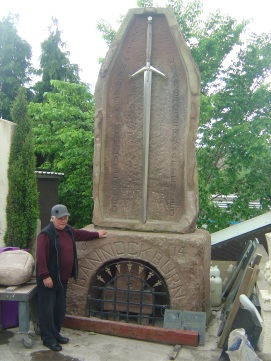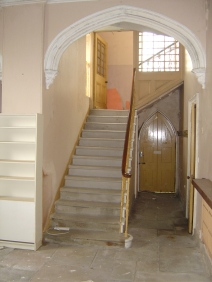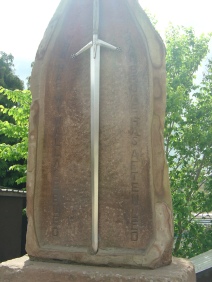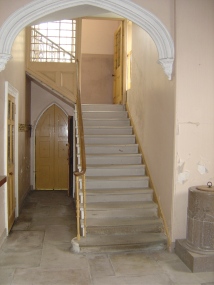 The sculptor of the famous “The Spirit of Wallace” statue, Tom Church (pictured), was showing me around his work shop when I saw this magnificent red sandstone monolith with a massive 12 foot long stainless steel broadsword attached and the words “Wha wi hae Wallace bled, wha Bruce has aften led” carved around it.
The sculptor of the famous “The Spirit of Wallace” statue, Tom Church (pictured), was showing me around his work shop when I saw this magnificent red sandstone monolith with a massive 12 foot long stainless steel broadsword attached and the words “Wha wi hae Wallace bled, wha Bruce has aften led” carved around it.
The words mean “Scots, who have with Wallace bled, Scots, whom Bruce has often led” and are taken from a patriotic song written in 1793 by Rabbie Burns, “Scots Wha Hae”.
The song was the unofficial national anthem for Scotland for centuries and is written as though King Robert the Bruce is giving a speech to his troops before the Battle of Bannockburn in 1314. The tune to which the lyrics are written is actually a far older traditional Scottish tune “Hey Tuttie Tatie” which according to legend was played on the bagpipes by Bruce’s army at the Battle of Bannockburn.
Now, the bottom half of this fantastic monolith is a small ‘cave’ with a replica ‘Stone of Destiny’ in it and the head of Robert Bruce, King of Scotland, looking at a spider;
The story of Bruce and the spider is taken from a poem written in the early 19th Century by Bernard Barton. It tells the legendary story of how Bruce, after six successive defeats by the English armies, took refuge in a cave and saw a spider trying to spin his web from side of the cave to the other. No matter how many times the spider failed, he tried again until he eventually succeeded giving rise to the popular saying “If at first you don’t succeed, try, try, try again.”
Bruce went on to win his seventh battle against the English at Bannockburn and gained Scotland’s independence.
And The Stone of Destiny?
Well, the stone is just a plain, oblong block of red sandstone with chisel marks on its flat top. It measures 65cm x 40cm and 27cm deep and was originally used as part of the crowning ceremonies of the Scots kings of Dalriada in the west of Scotland (now called Argyll).
When Kenneth I, the 36th King of Dalriada united the Scots and Pictish kingdoms and moved his capital to Scone from western Scotland around 840AD, the Stone of Destiny was moved there too. All future Scottish kings have since been crowned on the Stone of Destiny atop Moot Hill at Scone Palace in Perthshire.
So where did this magical or mythical stone originate from and why was it held in such high regard by royalty?
One legend dates back to biblical times and states that it is the Stone of Jacob taken by Jacob while in Haran (Genesis 28:10–22).
The stone was brought from Syria to Egypt by King Gathelus, who then fled to Spain following the defeat of the Egyptian army. A descendant of Gathelus brought the stone to Ireland, and was crowned on it as King of Ireland. And from Ireland, the stone moved with the invading Scots (actually Irish people called ‘Scots’) to Argyll.
The Stone of Des tiny remained at Scone until it was forcibly removed by the English King, Edward I (“Longshanks” or the “Hammer of the Scots”) after his Scottish victories in 1296 and it was taken to Westminster Abbey in London.
tiny remained at Scone until it was forcibly removed by the English King, Edward I (“Longshanks” or the “Hammer of the Scots”) after his Scottish victories in 1296 and it was taken to Westminster Abbey in London.
The current Coronation Chair was made to house the stone in 1301 and it was first used at the coronation of Edward II, and thereafter to crown every subsequent king and queen of England.
The Stone of Destiny now resides in Edinburgh Castle and is on display there with the Scottish crown jewels.
But with regard to the top part of this sculpture – the giant red sandstone monolith adorned with the wonderful 12 foot long broadsword – wouldn’t this be wonderful situated on the wall either side of the main staircases at the front entrance to the church building?
I can picture the walls behind it draped with tartan and a beautiful red carpet leading from the front door towards the monolith and on up the stairs either side of it.
This would be a fantastic focal point for the entrance to our Centre, particularly for brides getting married here.
It would certainly add another “Wow” factor to the place.
What do YOU think?



Recent Comments